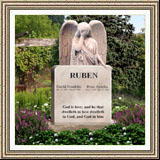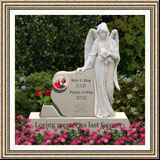|
"In a Time of Need"
By Kenneth Stephan
As I take my leisurely walk with my dog through the
older section of the local cemetery, I pause to read the
details on the barely legible, weathered headstones. I
am fascinated with the dates, for I know each stone has
a story to tell, a history of its own time and place,
but only enough space for identity. Proceeding up the
rolling asphalt pathway, I am led into the new section
of the cemetery. It becomes crystal clear as I compare
the cemetery's old sections with the new, Americans are
living longer.
The aging of people in the US over the next three
decades will have a huge impact on the way financial
planners conduct business. Most Granite boomers will reach
retirement age over the next 30 years, causing rapid
growth of the population over age 65.
According to the 1999 National Vital Statistics Reports,
a total of 2,391,399 deaths occurred in the United
States in that year. The age-adjusted death rate, which
eliminates the effects of the aging of the population,
was 881.9 deaths per 100,000. In 2001, a total of
2,416,425 deaths occurred in the United States. The
age-adjusted death rate was 854.5 deaths per 100,000
(U.S. Census Bureau 1999, 2001).
As the facts are stated, the financial planning
community will be working with much older clients in
years to come. This will dramatically change the
structure and methods used to create a successful
long-term relationship. We will have to re-think our
strategies in order to accommodate the client's
ever-evolving needs, both financial and emotional.
Throughout an active career it is inevitable that most
of us in providing financial advice will come into
contact with grieving clients at some time. When this
opportunity presents itself, we can play an instrumental
role in the healing process. Done properly, the value
added to the client relationship will be strengthened
and your personal rewards will be extraordinary. Done
improperly, the client could be adversely affected, both
emotionally and financially, possibly creating severe
consequences.
Adding to the complexity of mourning is the agonizing
process of dealing with the financial realities. Most
often the surviving spouse has to accept the ongoing
obligations of the family and business financial
commitments. Moreover, when Memorial are involved, the
larger issues become their health and financial welfare.
The financial advisor has many tasks to perform in a
relatively short period of time. Important financial
decisions need to be made, in some cases immediately.
Life insurance policies, investment accounts, trusts,
wills, deeds, debts, employee benefits, change in
beneficiaries, Social Security benefits and budgetary
issues, just to mention a few. When needed, the advisor
will request the assistance of an attorney and a tax
accountant to settle the estate.
The confidence and guidance of a trusted financial
advisor is crucial at this time so the grieving client
will be less burdened and therefore make fewer financial
mistakes. We should also recognize that we have
additional responsibilities due to the long-term nature
of the relationship. The mental health of the client is
as important as the financial health.
The financial-planning-community, banks, brokerage
firms, CPA's, and insurance agents have not yet
established any specialized training in bereavement as a
priority. For many reasons, mostly traditional,
financial advisors have had limited knowledge regarding
the proper methods in assisting the grieving client.
To begin, we must understand the "The Five Stages of
Grief ", (Kubler -Ross 1969). Without a thorough
comprehension of these stages the financial advisor
cannot fully understand what the client is experiencing.
We should be able to identify both psychological and
physical signs of grieving. Although the grieving
process is necessary, unresolved over a longer period
could seriously impair a persons self -worth and
effectively render critical decisions. Recognizing these
often- paralyzing symptoms may be the salvation to the
client and the family.
As financial professionals we can play a key role in the
client's lengthy healing process. How large a role you
play, will partly depend upon your knowledge and
understanding of the subject of grief and dealing with
its implications. Recognizing the five (5) symptoms of
the grieving process is an important condition to
building a solid relationship with the client.
Five symptoms of the grieving process
Denial
The individual is overwhelmed and refuses to believe the
loss is happening. This stage serves as a buffer in
helping the client mobilize defenses to cope with the
situation.
Anger
The individual resists the loss and may express his/her
anger by acting out toward family, friends and
health-care providers.
Bargaining
The individual attempts to postpone the reality of the
loss by pleading for an extension of life or the chance
to "make everything right"
Depression
This stage is characterized by an emotional void or
disinterest in outside matters. The individual finally
realizes the full impact of the loss and struggles with
the idea of separation.
Acceptance
The individual comes to terms with the loss and gains a
greater perspective of the situation and integrates the
loss with his/her reengagement in life.
While interviewing many grief counselors, funeral
directors, clergy, hospice care staff and volunteers,
one comment frequently surfaced. Each individual does
not follow the grieving process in any particular order.
Often, the person confronting the grief will address and
readdress a certain stage or stages repeatedly. The
grieving process is individualized and has no time
limits.
Grieving family members left behind struggle with their
loss. In many cases they believe their whole life has
collapsed and will feel every emotion imaginable and
some unimaginable. Their anguish, sadness, despair, pain
and sorrow may take away much of their purpose and
determination in life. Given the emotional turmoil
involved, this client requires a special kind of care.
The following attributes will help convey the financial
advisors concern and understanding.
Attitude
You should be genuinely committed to supporting your
client throughout the process. Trust and commitment may
have been established with your long-term client;
however, this bridge may need to be built or
re-established with a new client or the departed clients
spouse or family.
As with any professional/client relationship, trust and
loyalty take time and patience to establish. Your
patience and understanding at this critical time of need
will go a long way to affirming your commitment and
instilling the necessary confidence in order for the
client to know they are making the right decisions.
You must also be capable of dealing with real-life
situations while maintaining a high degree of
professionalism. Sensitivity, kindness and patience are
qualities that will embellish your relationship. Your
client has just gone through one of the most traumatic
experiences and they are naturally afraid of every
aspect of life, particularly in regard to their
finances.
Remember, your first priority is to provide your client
with a sense of security so they may gain confidence in
your decisions. Letting the client know that you have a
heartfelt conviction to guide them through this
difficult period will help establish a safe and
comforting atmosphere at this time when they have little
hope.
Share your positive outlook on life, for this stability
will offer the bereaved a sense of balance and hope for
the future. Your client will feel confidence as you
communicate your warmth and determination in approaching
their present circumstances.
Listen
This is an art that needs to be practiced. Its human
nature to want to respond as your client's concerns are
raised, however it is your obligation to let the client
speak. This meeting is about the client, not the
financial advisor. This is the client's time to air
their feelings. It is about their needs, concerns and
objectives. You will have time plenty of time to speak,
but it is not now. Continue to raise questions and take
notes.
Listening is a skill that cannot be overemphasized.
Listen closely and hear what the client is saying. They
will convey volumes of information, both financial as
well as emotional in a short time. For help in
developing your skills in this area there is an
excellent book: Listening: the Forgotten Skill: A
Self-Teaching Guide by MADELYN BURLEY-ALLEN, the founder
and president of Dynamics of Human Behavior. There will
always be room for growth in this area and the benefits
for your practice will be well worth the effort.
Empathy
Above all, your client must sense and understand that
you care for their emotional and financial welfare.
Revealing to your client that you are truly concerned
for their well being and have a deep understanding of
their present circumstances is worth more than your
credentials at this point. Trust and loyalty are built
upon honesty. These virtues are paramount to your
success and once established, you will have gained their
loyalty for life.
How to Get Started
Getting familiar with this topic will enhance your
knowledge in human behavior and the understanding
necessary before helping those at this critical time in
need of your services.
Volunteer at a local hospice and palliative care
organization. This can give you real hands-on
experience. It will be well worth your time and effort
because you will have an opportunity to learn first hand
from those who have had many years of experience in this
field. Additionally, it is a very satisfying experience
to serve people in this real time of need. It is true
that experience can be your best teacher.
Financial advisors and other professionals desiring a
better understanding of grief and bereavement can and
should get the basics from the many educational
materials available. You can start with the references
listed below.
Bookstores and public libraries generally have an
extensive selection on the subject of grief, death and
bereavement. Noteworthy are the following textbooks:
Death and Dying Life and Living, Charles A. Corr, Clyde
M. Nabe, Donna M. Corr, 4th Edition 2003, Wadsworth,
Thomson Learning Publishing Co. and The Last Dance:
Encountering Death and Dying. Lynn Ann DeSpelder and
Albert Lee Strickland, 6th Edition 2002, McGraw Hill.
Additionally, there are many private and public training
and certification programs throughout the country. The
American Academy of Bereavement (www.bereavementacademy.com),
through CMI Education Institute, Inc. provides a
Bereavement Facilitator Level I training program. The
American Academy of Grief Counseling (www.aihcp.org)
also offers a comprehensive certification program. A
Certification in Thanatology, (CT) is provided through
The Association for Death Education and Counseling (www.adec.org).
Most local colleges or universities offer introductory
courses as well as advanced degrees in grief and
bereavement.
Our Role
It is my hope and desire that the financial planning
community will begin the task of educating professionals
in the field of grief and bereavement. As the national
death statistics change, so should our methodology. We
are long overdue in creating a precedent in the
understanding of this critical area. You don't need to
become an expert or counselor in the field; this should
be left to mental healthcare professionals. However, to
be an effective advisor, we have to realize that
long-term relationships demand we play a crucial role in
the healing process as we serve our clients.
Beyond the fundamentals of the financial planning
process, it is ultimately the advisors choice to serve
clients with compassion and understanding as well as
technical competence. These attributes are not mutually
exclusive but interdependent requirements of mastering
your craft and becoming a trusted family advisor.
Future Vision
The financial planning community should begin
instituting a national program identifying a level of
expertise in grief and bereavement. Implementing a
training program through a series of continuing
education courses would be a positive first step.
However, a formal course providing the tools necessary
to integrate this skill fully into the financial
planning process would be optimal.
Identifying those professionals in the financial
community with the desire and knowledge to work in this
area could be of great benefit to those in need. An
acknowledgment of skill mastery could be conferred upon
successful completion of the grief and bereavement
course regimen. The value of this mark would be to
assure that those needing guidance would be receiving
advice from a financial advisor certified in this area.
New standards would be set forth for all financial
advisors, dramatically changing the way we deal with
this very natural but often ignored part of the planning
process.
A Road Less Traveled
As I am about to leave the cemetery, I have found a new
appreciation for the grieving client. I realize that for
the benefit of our society, the financial planning
industry must take definitive action on its approach and
understanding of grieving clients and their family
members.
Nearing the exit of the cemetery, my interest is piqued
as I am drawn toward an artistically- built structure.
This memorial stands above all others, it is the size of
a small house. It is built of solid granite, darkened
through the decades to a smoke black and gray with
exquisitely detailed workmanship. Four generations are
buried in this mausoleum, dating from 1809 - 1992. At
the entrance, a large granite plaque announces this
quote by Thomas Mann, "A man's dying is more the
survivors' affair than his own." This statement could
not be truer.
|





